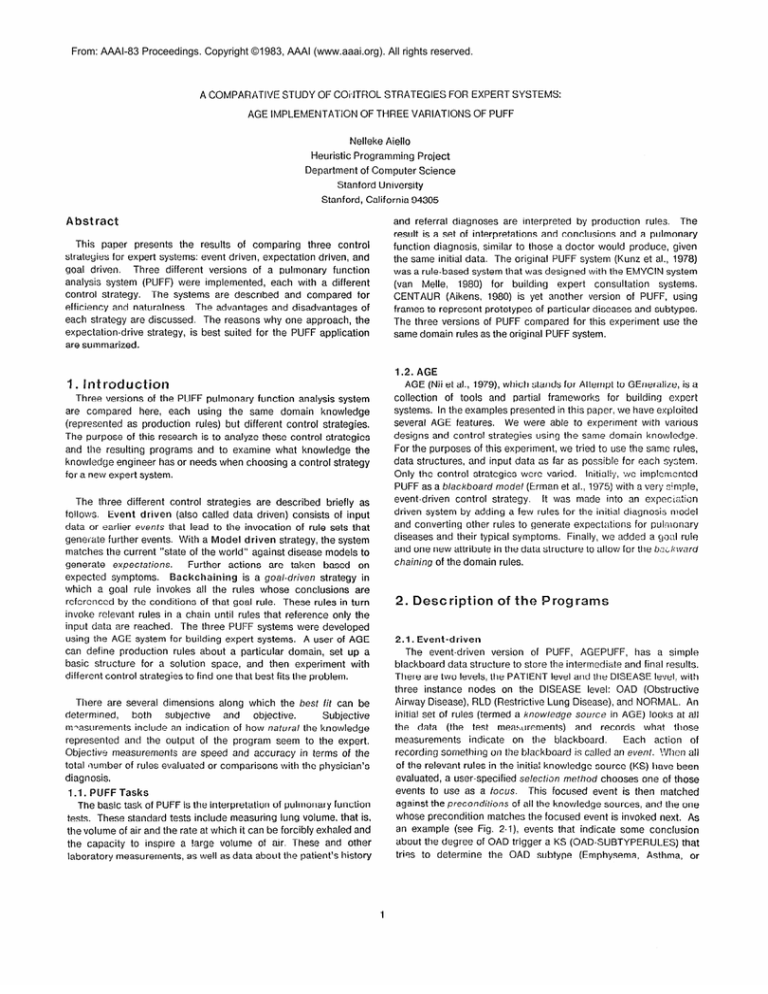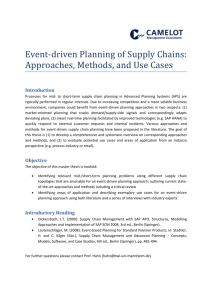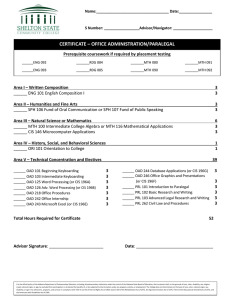
From: AAAI-83 Proceedings. Copyright ©1983, AAAI (www.aaai.org). All rights reserved.
A COMPARATIVE
STUDY OF COi>JTROL STRATEGIES FOR EXPERT SYSTEMS:
AGE IMPLEMENTATION
OF THREE VARIATIONS OF PUFF
Nelleke Aiello
Heuristic Programming
Project
Department of Computer Science
Stanford University
Stanford, California 94305
Abstract
This paper presents the results of comparing three control
strategies for expert systems: event driven, expectation driven, and
goal driven.
Three different versions of a pulmonary function
analysis system (PUFF) were implemented, each with a different
control strategy.
The systems are described and compared for
efficiency and naturalness. The advantages and disadvantages of
each strategy are discussed. The reasons why one approach, the
expectation-drive
strategy, is best suited for the PUFF application
are summarized.
I.
Intrsductiorl
Three versions of the PUFF pulmonary function analysis system
are compared here, each using the same domain knowledge
(represented as production rules) but different control strategies.
The purpose of this research is to analyze these control strategies
and the resulting programs and to examine what knowledge the
knowledge engineer has or needs when choosing a control strategy
for a new expert system.
The three different control strategies are described briefly as
follows. Event driven (also called data driven) consists of input
data or earlier events that lead to the invocation of rule sets that
generate further events. With a Model driven strategy, the system
matches the current “state of the world” against disease models to
generate expectations.
Further actions are taken based on
expected symptoms.
Backchaining
is a goal-driven
strategy in
which a goal rule invokes all the rules whose conclusions are
referenced by the conditions of that goal rule. These rules in turn
invoke relevant rules in a chain until rules that reference only the
input data are reached. The three PUFF systems were developed
using the AGE system for building expert systems. A user of AGE
can define production rules about a particular domain, set up a
basic structure for a solution space, and then experiment with
different control strategies to find one that best fits the problem.
There are several dimensions along which the best fit can be
determined,
both
subjective
and
objective.
Subjective
rn-asurements include an indication of how natural the knowledge
represented and the output of the program seem to the expert.
Objective measurements are speed and accuracy in terms of the
total number of rules evaluated or comparisons with the physician’s
diagnosis.
1 .l. PUFF Tasks
The basic task of PUFF is the interpretation of pulmonary fUrdOn
tests. These standard tests include measuring lung volume, that is,
the volume of air and the rate at which it can be forcibly exhaled and
the capacity to inspire a !arge volume of air. These and other
laboratory measurements, as well as data about the patient’s history
and referral diagnoses are interpreted by production rules. The
result is a set of interpretations and conclusions and a pulmonary
function diagnosis, similar to those a doctor would produce, given
the same initial data. The original PUFF system (Kunz et al., 1978)
was a rule-based system that was designed with the EMYCIN system
(van Melle, 1980) for building
expert consultation
systems.
CENTAUR (Aikens, 1980) is yet another version of PUFF, using
frames to represent prototypes of particular diseases and subtypes.
The three versions of PUFF compared for this experiment use the
same domain rules as the original PUFF system.
1.2. AGE
AGE (Nii et al., 1979), which stands for Attempt to GEneralize, is a
collection of tools and partial frameworks for building expert
systems. In the examples presented in this paper, we have exploited
several AGE features. We were able to experiment with various
designs and control strategies using the same domain knowledge.
For the purposes of this experiment, we tried to use the same rules,
data structures, and input data as far as possible for each system.
Only the control strategies were varied. Initialiy, we implemented
PUFF as a blackboard
model (Erman et al., 1975) with a very simple,
event-driven control strategy.
It was made into an expec&il:n
driven system by adding a few rules for the initial diagnosis model
and converting other rules to generate expectations for pulmonary
diseases and their typical symptoms. Finally, we added a goal rule
and one new attribute in the data structure to allow for the bz;kwnrd
chaining
of the domain rules.
2. Description
of the
Programs
2.1. Event-driven
The event-driven
version of PUFF, AGEPUFF, has a simple
blackboard data structure to store the intermediate and final results.
There are two levels, the PATIENT level and the DISEASE level. with
three instance nodes on the DISEASE level: OAD (Obstructive
Airway Disease), RLD (Restrictive Lung Disease), and NORMAL. An
initial set of rules (termed a knowledge
source in AGE) looks at all
the data (the test measurements)
and records what tlrose
measurements
indicate on the blackboard.
Each action of
recording something on the blackboard is called an event. When all
of the relevant rules in the initial knowledge source (KS) trave been
evaluated, a user-specified selection method chooses one of those
events to use as a focus.
This focused event is then matched
against the preconditions
of all the knowledge sources, and the one
whose precondition matches the focused event is invoked next. As
an example (see Fig. 2-l), events that indicate some conclusion
about the degree of OAD trigger a KS (OAD-SUBTYPERULES) that
tries to determine the OAD subtype (Emphysema, Asthma, or
Bronchitis). In other words, the events are driving the order in which
KSs are evaluated. This process is repeated until some termination
condition is met.
3’LbCl
Expectation
#+a
Process
+c
Expectation
Process
Yis
1
OAD-support
c"u
support
OAD-subtype<->
Ib
,_ >
RLD-DEGREERULES
&
support
RLD-degree&$-]
Figure 2-2:
I
RLD:OAD
OAD-sbbtype
(with circled nodes indicating knowledge sources).
The following is an example of a rule from the event-driven
system.
PUFF
if (UETWFEN*
($DATA SLOPE:F!jO/FVC)
22 32)
then PROPOSE
ev.type OAD-DEGREE
ch.type
MODIFY
hypo-element
'OAD
(DEGREE
‘((FE1025
'(MODERATE
*F5025*
)
driven organization
of AGEPUFF/MODEL.
history, and referral diagnosis) agree with the OAD diagnosis, then
the actions that reinforce the initial conclusion are taken; which in
turn generate events that trigger knowledge sources about OAD
reversibility and OAD subtypes.
Figure 2- 1: AGEPUFF knowledge sources
attr-value
(FINDINGS
Expectation
OAD-findings
.5))
1.01
If the condition of this rule is true, the DEGREE and FINDINGS
attributes of OAD will be updated on the blackboard, generating an
event of type OAD-DEGREE. This event is added to a list of events
and becomes the focus event on a last-in, first-out basis. A
knowledge source with a precondition of OAD-DEGREE can then be
invoked, and OAD would become the focus node.
2.2. Model Driven
AGEPUFFIMODEL
is the name of the model-driven version of
PUFF implemented in AGE. It uses the expectation control strategy
available in AGE to set up models of the pulmonary diseases. The
initial diagnosis rules check a limited number of crucial data items
and make an initial, broad diagnosis.
AGEPUFF/MODEL
then
attempts to substantiate the initial hypothesis with a few more data
If the diagnosis is still credible, a
items of secondary importance.
set of further
model-based
expectations
is generated
for
corroborating evidence. AGE compares the expectations with input
data and partial hypotheses on the blackboard.
Figure 2-2 shows
the organization of the knowledge sources for the expectationdriven model.
The models of OAD and RLD help to focus the interpretation of
the input data. For example, if a patient has a total lung capacity
greater than 120 percent of the normalized value for his size and
age, it is very likely that he has OAD. So, instead of checking all the
example,
the
event-driven
data,
as
in
available
test
AGEPUFF/MODEL looks first, and possibly only, at other indicators
of OAD. If enough other indicators (test data, calculations, patient
The following
system.
is an example
of a rule from the model-driven
if (EQDEG*
($VALUE
'OAD DEGREE) MODERATE)
then EXPECT expr (BETWEEN'
($DATA
SLOPE:F50-F25/fVC)
22 32)
actions
(PROPOSE
ev.type OAD-SUPPORT
ch.type MODIFY hypo-element
'OAD
attr-value
((DEGREE
(MODERATE
.5))
(FINDINGS
'((F6025
*F5025*)
1.01
EXPECT expr (GREATERP"
($DATA FVC/FVC-PRED)
80) (BETWEEN*
(DIFFERENCE
($DATA
FEVl/FVC)
($DATA PRED:FEVl/FVC))
EXPECT
-25 -15)
actions
.. .
...
When this rule is executed, several expectations are generated.
The expectation expressions (expr) are evaluated in a last-in, firstout order and, if true, the actions are taken. These actions can
generate events, just as in the event-driven system.
As noted above, the expectation-driven
approach is really a
combination of an event and expectation strategy. No system can
function on expectations
alone.
Events are used to generate
information for the expectations and to act when an expectation is
met.
2.3. Backchaining
The backchained version of PUFF, called PUFFIBC, has or,ly one
knowledge source. All the PUFF rules are combined into one large
knowledge source.
The rules are chained
by looking at the
conditions of the goal rule and then searching for other rules whose
actions might provide values for the goal rule’s conditions.
This
imposes a more restrictive syntax on the conditions of rules than in
the event-driven or expectation-driven
approaches.
The backward
chaining process requires that the conditions
be written as
predicates, with explicit object and attrlbute names. (In the other
two systems, the predicates can be arbitrary LISP expressions.)
AGE automatically chains the rules by searching for rules whose
actions reference the same object-attribute pairs as the conditions
strategy does less testing and refers less often to data than the other
two strategies do. The ability to focus initially on the most likely
diagnoses eliminates the need to test rules for other diagnoses. A
few more rules are executed in the model-driven and goal-driven
strategies to set up the expectations or goals. The goal-driven
strategy has the most references to internal data because every
predicate refers to an object-attribute
pair, each rule may have
several predicates, and all the rules are tested for each run.
of the goal rule. This chaining process is repeated, with the rule
whose actions referred to the desired object and attribute becoming
the next subgoal rule, until conditions are rxeached that only
reference input data.
3.2. Accuracy
with the doctor’s
Accuracy
was measured as agreement
based on the statements
PUFF is capable of
conclusions,
producing. When the strategies are compared by the number of
correct interpretations and diagnoses, the event-driven and goaldriven strategies are slightly more accurate than the model-driven
strategy.Given odd or marginal data, the model-driven StrateClY
may
produce incomplete interpretations.
It will not produce incorrect
The event-driven strategy is initially data
statements, however.
driven and therefore responds to each data item, odd Or normal.
The goal-driven
strategy evaluates all of its rules, independent Of the
particular input data. In other words, the event-driven and goaldriven strategies will produce all conclusions derivable fora given
set of input data. But the model-driven strategy will produce only
conclusions compatible with its initial diagnoses and wil produce
results derivable from the models for those diseases.
Figure
2-3:
Organization
3.3. Naturalness to the Expert
Accuracy can also be evaluated subjectively in terms of the
naturalness of the knowledge represented and the output.
A
knowledge
representation
that seems natural to the expert
facilitates
knowledge
acquisition
from
the
expert
and
comprehension
of the system by the expert.
A natural output
includes the order in which interpretations
are generated: They
should be produced in an order similar to that produced by the
expert.
of knowledge sources for Backchaining.
An example of a rule from the PUFF/%
system follows.
if (UErWEEN*
DATA SLOPE:F50-F25/FVC
22 32)
then object OAD attribute-value
pairs (DEGREE
('MODERATE
.S))(FINDINGS
((F5025 *F5025*
1.01
in this case, the value of the attribute SLOPE:F50-F25/FVC
of the
node DATA will be passed on as an argument to the predicate
BETWEEN*. When this rule is evaluated, rules referring to DEGREE
and FINDINGS of OAD in their predicates can be evaluated next.
3. Results
of Comparing
Strategies
the Three
3.1. Speed
The three control strategies were objectively
compared for
efficiency by measuring the number of rules tested, the number of
rules executed, the number of input data items referenced, and the
number of references
to the blackboard
or internal
data
representation in the backchained strategy.
Table 3-l shows the
average results for the three strategies for a small sample of actual
cases with diagnoses that range from mild to severe cases of
and various
disease categories
OAD, RLD, and NORMAL,
There was very little deviation from the
combinations thereof.
average for each measurement.
From this objective measurement
it is clear that the model-driven
Table 3- 1:
Strategy
event-driven
model -driven
goal -driven
rules
tested
60.4
35.5
68
3.3.1. output
The order of the output of interpretations
in all three PUFF
systems is determined by the order in which those interpretations
are concluded. We compared these orders with the interpretations
from the original physician’s reports. For each case, the number of
items out of order was calculated by counting the minimum number
of moves required to reproduce the doctor’s order.
output
generated by the model-driven system always had fewer findings out
of order. The event-driven system had the next fewest out-of-order
items, and the goal-driven system had the most. This result was not
unexpected, since the model used by AGEPUFF/MODEL is based
on the doctor’s
order of reasoning
from pulmonary
test
measurements to pulmonary disease diagnoses. The backchained
system produced the most items out of order because the order of
execution of the rules is determined by the chaining of attributes. A
rule is executed because another higher goal rule needs the value
of one of its concluding attributes, but all other conclusions of that
rule will be made at the same time, even though those conclusions
are not required until later in the processing.
3-3-2. Knowledge
Representation
The domain knowledge
used by each of the three control
strategies is basically the same. All three use production rules to
rePresent the domain knowledge. They differ in how those rules are
Measured Comparison of Three Controi Strategies
rules
executed
12.6
14.5
14
input
80.4
47
76
data
internal
54.4
48.5
128.8
data
organized. In the event-driven approach, the rules are divided into
sets called knowledge sources. A knowledge source is invoked
when its precondition matches the event type of the focused event.
The model-driven system also has sets of production rules, but
some of those rules create expectations
instead of generating
events. The expectations (in this case, a set of ranges for data
values to support the focused initial diagnosis) are matched against
input data and the partial solution stored on the blackboard, before
further KSs are invoked. If an expectation becomes true, it becomes
the new focus. In the backward-chained
system, the rules are not
stored in any particular order or grouping. The order of evaluation
and the focus are determined at run time by the backward chain
from the goal rule.
3.4. Advantages and Disadvantages of Each Strategy for
implementing PUFF
The event-driven control strategy is robust; it considers all of the
inpuf data, and tries to follow through on every event generated.
Because of this thoroughness,
it worked correctly even in the
presence of unusual and incomplete data. However, the eventdriven approach can bc nonconvergent.
Event-driven systems can
only produce conclusions derivable directly or indirectly from the
input data. They cannot focus on or direct the search toward a
desired solution.
The expectation-driven
model is usually more efficient than either
of the other two examples. It can focus on important factors and
come immediately to the correct conclusions
for most cases.
However, odd or conflicting data, that do not fit the model will cause
problems. Thus, a disadvantage of the model-driven paradigm is
that the correct solution depends heavily on the correct model and
initial focus.
If the system begins by focusing on an incorrect
diagnosis, it will check only the data that are relevant to ihat wrong
diagnosis. Data indicative of another diagnosis would be ignored.
The importance of the correct model was demonstrated during the
implementation of AGEPUFFIMODEL.
The first model implemented
worked correctly for extreme indications of OAD and RLD but
expected everything
in between
to be normal.
The normal
expectations were correctly unconfirmed, but the system could not
go back and correctly diagnose mild or moderate OAD or RLD.
The backchain example has several advantages. First of all, it is
simple for the user to understand and it lends itself to easy
explanation of its reasoning. At each step of the execution, the next
step is predetermined.
The rules will always be evaluated in the
same order, regardless of the particular input data. However, this
does make the backchaining approach inefficient. Many of the rules
in the backward chain may be totally irrelevant for a particular set of
input data values, especially normal, healthy values. It cannot focus
on particular data items in different sets of input data because it has
no mechanism for deciding what is important and what is not. The
goal of diagnosing pulmonary diseases is the same for every case,
for every set of test data.
4. Conclusion
All three approaches use a divic!e-and-conquer
approach to
solving the PUFF problem, but they differ in how the domain
knowledge is divided.
In the event-driven system, knowledge is
divided by its association with the input data. A particular value of
an input data item can cause a rule to conclude the presence or
severity of a disease. That disease then becomes the focus for the
next set of rules (KS) evaluated.
Or several input data items can
together cause a rule to conclude a new value for some item on the
blackboard that then becomes the new focus. The focus of the
system stays with a particular input data item, and all conclusions
based on it, until there are no more KSs to draw further conclusions.
The expectation-driven
system organizes its knowledge around
its disease models, the expected symptoms associated with each
The focus of the system varies with the initially
disease.
hypothesized diagnosis. This focus is much stronger than that of
the event-driven system. In most cases, the system considers only
one or two diseases, making all possible conclusions about one
disease before considering the alternatives. In the event-driven
approach, each individual input data item could trigger a short
focus on a particular diagnosis, with support building with each
additional focus on the same diagnosis.
The goal-driven strategy is focused by the backward chain
connecting the production rules. It looks at data relevant to the goal
rule’s conditions and thus focuses on each disease, present or not.
In the event-driven and goal-driven approaches, all of the input data
have the same importance.
In the model-driven approach, some
data items are more important than others. Input data used by the
model to generate initial diagnoses are always referenced; data
items referring to diagnoses not in the initial hypothesis may be
ignored.
The characteristics of the PUFF problem that make it a good
application for an expectation-driven
control strategy include:
1. A large amount of input data.
2. A small solution space (three possible diseases
plus a small number
of
subtypes).
3. A simple model for initial hypotheses.
Applications with similar characteristics are signal processing and
other diagnostic problems. Other systems written in AGE using the
expectation-driven
control strategy include AGE-WI, a ventilator
management system (Fagan, 1980), and GEO, a geological data
interpretation
program. Each new application is likely to have
slightly different characteristics from the last, so it is not reasonable
to expect one control strategy to satisfy everyone’s needs.
5. Acknowledgments
This research was supported by the Advanced Research Projects
Agency under Contract No. MDA 903-77-C-0322 and the National
Institutes of Health Grant No. RR-00758.
6. References
1. Aikins,
J. S.
Prototvpes
Representation
Heuristic
Q
Programming
University,
and
Production
Computer
Project,
Dept.
of Computer
solving using many diverse cooperating
Settmq.
VM: Representinq
Doctoral
Computer
dissertation,
Science,
Stanford
organization
for problem-
sources of knowledge.”
Science,
Stanford
Fagan,
L., and
System for Interpreting
(Working
Paper),
Time-Deoendent
Heuristic
University,
4. Kunz, J., Fallet, R., McClung,
Science,
Knowledqe
dissertation,
In Proc.
pp. 483-490.
3. Fagan, L. M.
J. S.,
A
Doctoral
1980.
2. Erman, L. D., and Lesser, V. R. “A multi-level
IJCAI-75,
Rules:
Consultations.
Pulmonary
Heuristic
Physiological
Function
December
programs”.
In
Proc
Rule
Test Results.”
Project,
Dept.
Based
HPP-78.19
of Computer
1978.
5. Nii, H. P., and Aiello, N. “AGE: A knowledge-based
knowledge-based
Dept. of
J., Votteri, B., Nii, H. P., Aikins,
E. “A
Programming
Stanford University,
in a Medical
Project,
1980.
D., Osborn,
Feigenbaum,
Relations
Programming
of
program for building
IJCAI-79,
Tokyo,
Japan,
August, 1979, pp. 645655.
6. Van Melle,
W. EMYCIN.
for Consultation
Project,
A Domain-independent
Production-rule
Programs,
Doctoral
dissertation,
Dept. of Computer
Science,
Stanford
Heuristic
University,
System
Programming
1980.




